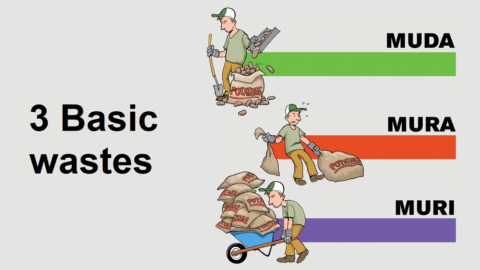
How to identify common waste with the 3M approach (Part 1)
Identifying waste with a 3M approach can make it easier for you to set goals and facilitate the avoidance of repetition of unnecessary efforts (muda), the inconsistencies of those efforts (mura) or restrict the cause of stress (muri).
Muda deals with waste in its simplest way: any activity that does not create added value is Muda. From a lean point of view, there are seven basic types of waste in production, each representing a common cause of loss in the process. It includes: Waste due to defective product, waiting, shipping, inventory, overproduction and unnecessary effort. Accordingly, Muda can be described in a relatively intuitive way, while the concepts of Mura and Muri need to be explained more.
Mura is often translated as inconsistency or heterogeneity, particularly at production norms, such as the wasteful allocation of materials or human resources. Specifically: Employees may be directed to work intensely during the morning shift, while the afternoon workload is so low that it is scarce. Such inconsistent scenarios can negatively affect both workers and machines, creating fatigue, stress and increasing unnecessary accident rates.
Muri is an overload of equipment, facilities, and people. Muri pushes machines or humans beyond their natural limits, causing fatigue, stress and increasing the likelihood of an accident. Overloaded equipment can also lead to malfunctions and increase errors, waste materials and reduce overall performance.
For most waste situations, whether it be Muda, Mura or Muri, the following causes are often found:
– Personnel have not been appropriately trained
There are no standards to comply with
– Employees are provided with tools that are not suitable for the job
Accordingly, reducing waste will revolve around solutions to these problems. In the case of a manager who needs to keep track of the tasks his team needs to complete, for example, making an email list can make things more difficult than necessary, while this looks seems very disciplined and well-regulated. Each member’s response time, as well as the manager’s time for aggregating and processing information, could be used more appropriately in other ways, such as a target standardized online notebook. So that all members can update their progress at any time.
In general, if you are looking to tailor the output in your production line to eliminate the waste of overproduction, implementing a Kanban system following 3M approaches is a simple method to ensure that Production only takes place when needed. By focusing innovation activities on the removal of parts that do not add value in the manufacturing process, your organization can strike a balance between capacity and workload.
Source: Kaizen News